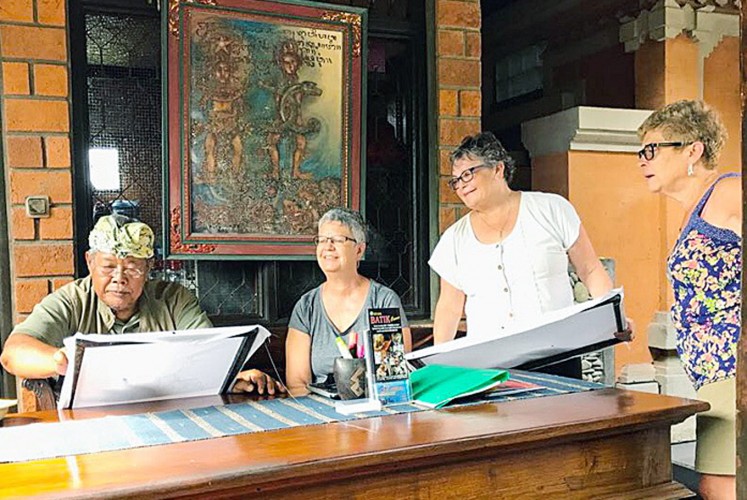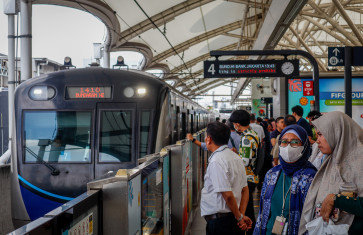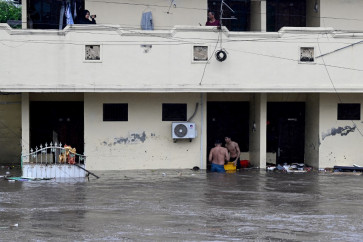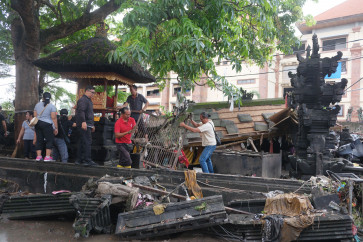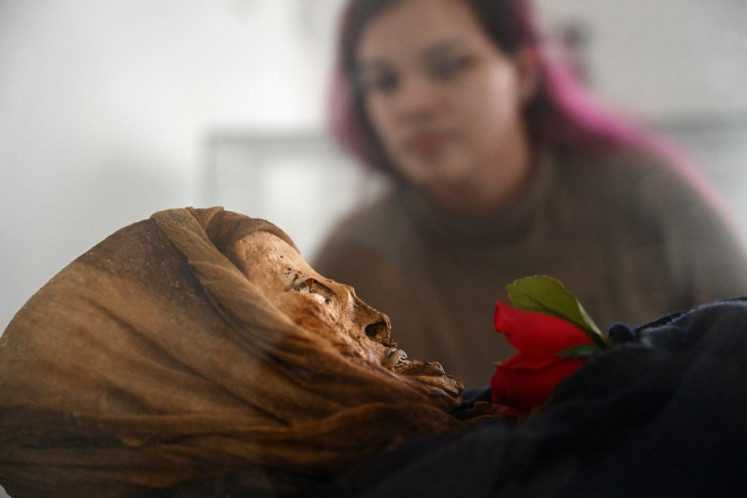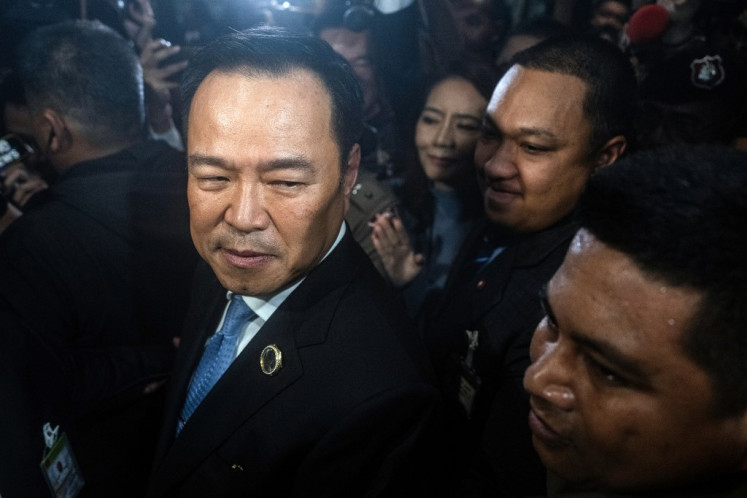Popular Reads
Top Results
Can't find what you're looking for?
View all search resultsPopular Reads
Top Results
Can't find what you're looking for?
View all search resultsGoodbye Daddy: The life and times of Nyoman Suradnya
The artist helped many discover the true face of Ubud.
Change text size
Gift Premium Articles
to Anyone
J
ust sixteen years old with almost waist long hair, loose pyjama pants, a shoulder bag and sandals, I stepped off the only daily bus from Denpasar one afternoon in Ubud in late 1971.
Broke but optimistic, I wandered south through the market that in those days spilled out on to monkey forest road. It had already shut down for the day, the stalls with their flat bamboo woven shades empty. Rice fields began right where the football field is now, nothing downhill from there but rice fields and the narrow dirt track that led to the Padang Tegal Cemetery in the forest that is now known by its English name, Monkey Forest.
Across the potholed main road, Ubud’s wantilan, the closest thing to a town hall, had a big banyan tree towering over it to the north. It was under this tree that two of Ubud’s most iconic warung (food stalls) of the time were to be found. Ibu Rai’s nasi campur (mixed rice) plate on the eastern corner, and just next to it, separated by a woven bamboo bedeg (wall) to the west of it was Okawati’s, who had already begun to cater bit by bit to western tastes.
At Okawati’s you could have prut saladde (fruit salad) even if she only was catering to the three or four non Balinese living in the what was still the village of Ubud. Fresh fruit, condensed milk and fried peanuts. If fruit salad wasn’t your thing, you could order instant oatmeal!
But most important that morning was the presence of a big, burly, young Balinese man with a large head and big beaming smile. I would add that he wore a Balinese sarong, but in those days everyone did.
“Selamat pagi [Good morning],” came a deep, booming voice out of that smile.
Nyoman Suradnya alias Badung was the first person in Ubud who befriended me. I think he found me an interesting oddity, and he was always curious about the world around him. Young and somewhat innocent (not that we thought that), that morning we chatted like old mates. He had a spontaneous openness and seemingly endless sense of humor.
He also knew everyone in town — he would fill me in with short, pithy descriptions of who they were. And everyone in town knew him and liked him. Already then, he was a bit of an icon.
One by one, I got to know many of the people who would walk up from the main road and up the dirt track that was to become Jl. Suweta.
There were no road names, no house numbers, no electricity, no asphalt beyond the main road and no phones. Addresses were by banjars (traditional community unit), subaks (traditional farming and irrigation system), temples or the vicinity of large trees.
But it really didn’t matter because it was a community; everyone knew each other and where they were at any given time of day, it was an endless web of interrelationships sealed by marriages and loyalties. “Outsiders” like myself were a tiny minority. An outsider could be forgiven for not registering that this community too had experienced the horror of dreadful bloodletting only six years before, during the 1965 massacres.
I also got to know many of Ubud’s movers and shakers sitting there. This was Nyoman’s world. Nyoman too was to become a mover and shaker in Ubud.
He was a vigorous mix of romantic, emphatic Balinese who later on would wear his sarong to Australia; down-to-earth practicality that had him driving trucks delivering chilies and such to Java; and an artistic calling that eventually became his “profession”.
Dancing hands: Nyoman Suradnya taught Western visitors the art of painting batik. Those who attended his workshop found that they learned a lot more than just painting batik. (Nyoman Suradnya’s family/File)But above all Nyoman had a vision for his beloved Ubud: the tourists that came — we called them tamu (guests) in those days — would be sensitized to Balinese culture and way of life, giving them an opportunity to immerse themselves in Ubud while avoiding the harm that was already beginning to be wreaked at Kuta and Legian in the early 80s.
Perhaps his closest friend was Cok Raka Kerthyasa. These two, the commoner and the prince, were to have many adventures together and even the odd hilarious misadventure.
Nyoman soon became established as an artist, and spent time as an artist in residence in Sydney, Melbourne and Singapore.
Asri, Cok Raka’s Australian wife, recalls the two of them setting off on a train to visit a town just west of Sydney.
“Being Balinese, they both simply relaxed and fell asleep. When they woke up they were at the end of the line somewhere way in interior and had no idea where they were! And no mobile phones in those days, so you can imagine [...].”
Driven by a vision of sustainable and sensitive tourism, in the early 80s the two formed Bina Wisata (guiding tourism). Bina Wisata set out to not only provide information to tourists but lead them into discovering the real Ubud: cultural and destination experiences that would cause minimum damage and instead benefit the community.
It wasn’t a business, it was a community service. It really was in character for Nyoman: he took delight in connecting with people and helping them discover new things, and he loved his community, flaws and all.
Larger than life, he would spontaneously reach out to people on first encounter, and often change their lives. His homestay, filled with his laughter and love of life, was an inspiring starting point for many who would become deeply involved in Ubud and Bali.
Recalling author Diana Darling: “I stayed at his homestay when I was first chasing John Darling in 1980. What a lovely happy host Nyoman was.”
Many too were visitors who got their first experience in creativity by joining one of his workshops.
However, time proved to be unkind to Nyoman’s Ubud. Bina Wisata was turned over to the village council’s Community Welfare Organization, which at first continued to serve the community. Yet as more and more tourists started to flow into the place, Ubud’s character started to change along with the type of people it had started to attract.
I can’t guarantee that this was something that triggered the following rather astounding event. One night there was a barong performance in the Ubud wantilan. Not necessarily sacred, at least in the hazy fog of my memory, but with all the elements present.
All of a sudden there was a scream and Nyoman leapt up in trance. The whole audience stared agog as Nyoman, kris in hand went flying over the gamelan, the terrified musicians ducked as low as they could as his large corpulent figure didn’t quite soar above them, sarong aflap.
Honestly, to this day I can’t figure out if he really was in deep trance or whether he was just making a pointed statement – or perhaps both.
By the mid 90s mass tourism flooded this once sleepy village, drowning out Nyoman’s dream. The community took second place to commerce, culture became something of a commodity. Industrial tourism brought foreign investors, fancy hotels and traffic jams. Kuta had come to the hills.
Nyoman slowly began to retreat. He remained true to his vision, but its realization had became more and more remote. The likelihood of ever achieving the dream went from improbable to near impossible.
Slowly but surely he withdrew more and more to the sanctuary of his home and guest house on Jl. Gotama. Here his wife Rai, as diminutive as he was large, looked after him, and eventually his son Putu Adi and daughter-in-law Kadek Purnami would all spend time looking after “Daddy”.
Though he still loved to see his old friends, the vigor and fight began to leave him. His melanchonic side began to dominate. In the last few years, as he became more infirm, it was rare to get a sighting of him outside of his home.
This month in hospital in Mas, various complications of heart, lungs and kidneys started to overwhelm him. At 10 p.m. on June 14, suddenly a large flock of herons appeared above the hospital and flew around in a swooping circle three times. It was such an unusual sight that people came out and stared.
That night Cok Raka said he was praying at the Gunung Lebah temple in Campuhan when suddenly he saw Nyoman sitting next to him: Cok nearly jumped out of his skin.
I woke up at 2:30 a.m. exactly, with a puzzled feeling that something had woken me up. I reached for my phone to check for earthquake notices, but nothing significant was to be found there. Unable to go back to sleep I got up. Then came the news that Nyoman had finally left his body on June 15 at 2:30 a.m. It was as if he was reaching out one last time that night in his ever unconventional manner.
Now his friends are left with a mixture of relief that his suffering is finally over and a sadness that he has taken with him an Ubud that is no more. We lost a gem that morning.



